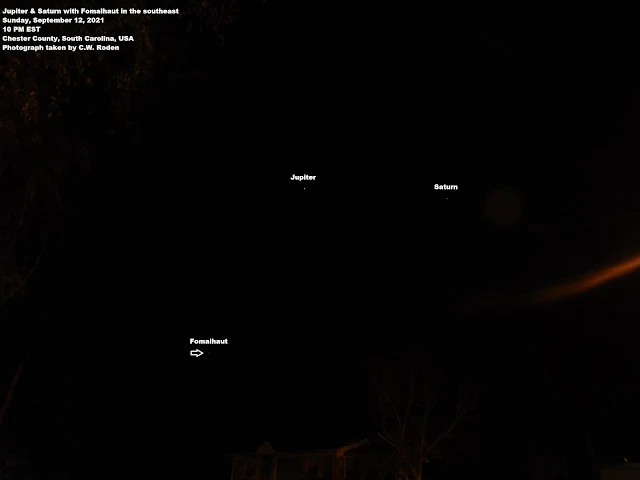Good evening fellow stargazers!
The summer of 2021 will soon be coming to a close here in the Northern Hemisphere with the arrival of the autumn equinox on Wednesday the 22nd later this month.
Here in my little corner of Dixie, the fireflies will soon disappear for the year -- as will all those loud Cicadas! -- and the sunshine will soon make way for earlier and earlier evening skies. The stars overhead in our sky dome will also change with the tilting of the Earth towards the winter constellations over the next few months.
The bright red star Antares, the summer star for the Northern Hemisphere, will continue to appear to move westward following the setting sun.
This evening Antares was close to our lovely Luna, still a day away from her first quarter phase, and I was able to capture a really good shot of this conjunction just above the tree line.
The name Antares itself means "The Rival of Ares" (the Greek name for their god of war, Mars for the Romans) because of the star's distinctive red coloring and the fact its noticeably brighter in the sky dome than Mars, except for those times ever two years when the Red Planet is in close opposition to the Earth. In actuality, Mars is actually more of an orange-yellow glow, while Antares is always quite red as you can see in the photo.
Antares is a red supergiant star approximately 604 light-years from our Sun. In terms of size, Antares is about 700 times larger than our own star and about 9,000 times brighter. So big that if Antares replaced our own Sun in our Solar System, it would engulf all of the inner planets and the asteroid belt!
Yet, despite this massive size, Antares is relatively cooler than our sun. Our bright star burns as a whopping 11,000 F while Antares is somewhere around 6,500 F -- still pretty hot, but cool as far as stars go. This lower temperature is what gives Antares its distinctive red coloring.
While Antares appears as a single star when viewed with the naked eye, but it is actually a binary star, with its two components called Scorpii A and Scorpii B. The brighter of the pair is the red supergiant itself, while the fainter is a hot main sequence star.
A couple of hours later into the evening I captured a bright trio in the southeast: the two gas giant planets Jupiter and Saturn, along with the bright white star Foralhaut.
Fomalhaut (Alpha Piscis Austrinus) is sometimes called the Loneliest Star because it’s the only bright star in a wide stretch of sky. It's also called the Autumn Star because it appears more clearly in the southern sky in the fall months in the Northern Hemisphere. Fomalhaut certainly can be considered to be the star that announces the arrival of fall in the Northern Hemisphere because it stands out
in what is otherwise a rather empty region of the autumn sky.
The 18th brightest star in the night sky, Fomalhaut is part of the faint Constellation Piscis Austrinus, the Southern Fish. The name Fomalhaut derives from the Arabic Fum al Hut, meaning Mouth of the Fish.
Fomalhaut is a hot bluish-white star about 25 light-years away. It’s almost twice the mass and size of our Sun, but radiates at about 17 times the Sun’s energy. Fomalhaut itself is a young star, just 440 million years old. That’s in contrast to the estimated 5 billion years for our Sun. Because Fomalhaut is hotter and brighter than our Sun, it also has a
shorter life span of somewhere around 1 billion years. Stars like our Sun have life spans of about 10 billion years.
Both Antares and Fomalhaut are considered to be two of the four key stars of the night sky, sometimes referred to as the Royal Stars, or the Celestial Guardians (or "archangel stars"): Antares as Uriel, the Watcher of the West; Aldebaran representing Michael, the Watcher of the East; Fomalhaut representing Gabriel, the Watcher of the South; and Regulus as Raphael, the Watcher of the North.
Well folks, I hope y'all enjoyed my photos and presentation. Please let me know in the comments below and, as always, have a wonderful Dixie Day and y'all keep your eyes to the night skies, ya hear!


No comments:
Post a Comment